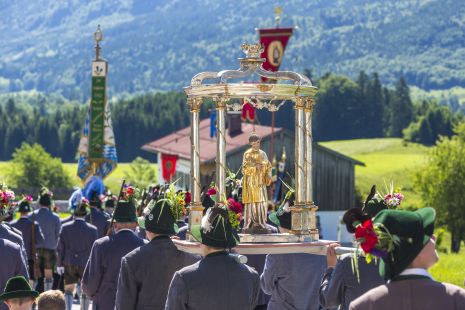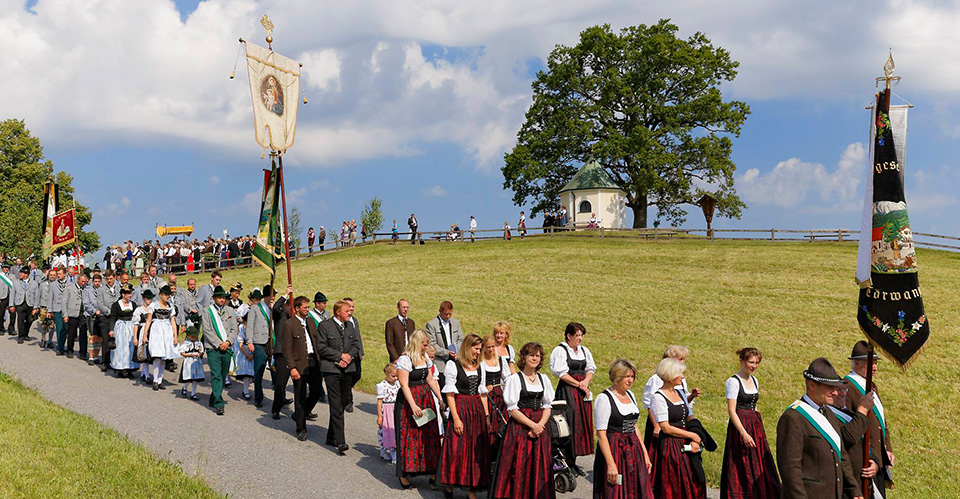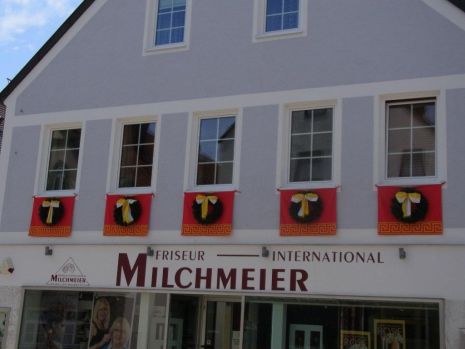The Corpus Christi festival
Corpus Christi Day, which is celebrated on the 60th day after Easter Sunday, always falls on a Thursday (at the earliest on the 21st of May, at the latest on the 24th of June). However, it is an official holiday only in six of the 16 German states and in individual communities of Thuringia and Saxony. The Catholic feast puts the physical presence of Jesus Christ at the center. A consecrated wafer or Host is exhibited in a precious monstrance and shown around in all four directions during the procession.
Originally, Corpus Christi was to be held on Maundy Thursday. However, the joy of Christ's presence and the coming of spring did not fit the mourning time before Easter. Therefore, the celebration was postponed to a later date after Easter.
The procession on the "pillory" or "blood" day
After the Holy Mass with the Eucharist, there is a traditional procession through the streets and over the farmland of the communities. At up to four stations with outdoor altars, traditional songs such as Thomas of Aquin's "Pange lingua" and the "Tantum ergo" are still sung in Latin. Praying and singing, the believers follow the priest who carries the precious monstrance under a canopy supported by four people. If possible, a brass band is hired to lend a special solemnity to the parade.
The origins of Corpus Christi, "vrône lîcham" = body of the Lord" date back to the 13th century. Pope Urban IV declared it a church festival in 1264. He declared that the victory over heresy was a reason for the introduction.

Traditional processes
The order of groupings participating in a procession is more or less strictly adhered to nowadays. In former times there was one or the other dispute, as it was a matter of prestige where one's group was marching in the row. Decorating the outdoor altars with ornate floral images with bible motives such as fish, lamb, the PX symbol or a goblet is still a matter of honor. It is often taken over by long-established families, but also by children celebrating their first Holy Communion or their Confirmation in the respective year. It is believed that the flower decoration goes back to the Order of the Franciscans - the poor scatter flowers for God. And so only the priest is allowed to enter the beautiful carpets.
During the procession, the community prays litanies, singing clerical songs and listening to prayers and readings at the stops with services on the outer altars.

Decorated processional route
Not only the laying of the flower carpets is a matter of honor. The houses along the procession path are also festively decorated. On the fences, yellow-white paperflags are stuck, additionally put up with green branches or small birches. The yellow color in the yellow-and-white Catholic flags heraldically replaces gold, which up to the present day represents the imperial, stately sun-color. The banner flags in front of the parish church and the long fabric draped from the ceiling to the floor in the sanctuary are also in yellow and white. Depending on local conditions, these sewn or printed flags can be customized by experienced flag suppliers.

The window sills are covered with Corpus Christi cloths. These mostly red fabrics show ecclesiastical motives, crosses, goblets, hosts, the Christ monogram PX, the letters IHS or aureolas. Red symbolizes the blood of Christ, the mostly golden embroidery or the golden ribbons are supposed to represent the glory of God. These cloths can be purchased at dealers of church supply, either with sewn laces or also in printing. Anyone who still attaches importance to ornately made accessories is at the right address in a flag embroidery that also specialises in ecclesiestical embroidery.
In the times of the guilds when the sequence of the processions was still strictly adhered to and regarded as a matter of prestige, one could also show one's position and demonstrate one's wealth by elaborate cloth decoration. The parades led through the main streets, the altars were built by the richest peasants or guild members. Intricately embroidered Corpus Christi cloths showed the passing members of the parish where the wealth was at home.
Living faith
After moving over the fields and through the streets, the faithful meet again in the church and sing "Great God we praise you". Many people take home small twigs of the birches or parts of flower arrangements from the sanctuary, believing that they protect their homes and families from harm. In most communities, the Feast of Corpus Christi concludes with barbecues during which the brass music welcomes spring with joyful, secular songs.

 English
English  Deutsch
Deutsch